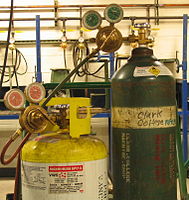
Photo from wikipedia
In this study, the effects of the lower outlet on the flow field of small gas–liquid cylindrical cyclones are investigated using Reynold stress turbulence model. Under the same operating conditions,… Click to show full abstract
In this study, the effects of the lower outlet on the flow field of small gas–liquid cylindrical cyclones are investigated using Reynold stress turbulence model. Under the same operating conditions, four configurations with different outlet styles and angles are established. The time-averaged tangential velocity, axial velocity, and root mean square velocity are compared, respectively. It is shown that many local secondary flow patterns are present in small gas–liquid cylindrical cyclones, and those flow patterns may cause serious energy losses. The lower outlet mainly influences the gas–liquid cylindrical cyclones flow field in the central region. The small gas–liquid cylindrical cyclones with single rectangular outlet provides a steady flow field and a large backflow zone, which are helpful in improving the separation efficiency. According to the simulations, a single rectangular lower outlet is the optimal one for small gas–liquid cylindrical cyclones.
Journal Title: Proceedings of the Institution of Mechanical Engineers, Part C: Journal of Mechanical Engineering Science
Year Published: 2019
Link to full text (if available)
Share on Social Media: Sign Up to like & get
recommendations!